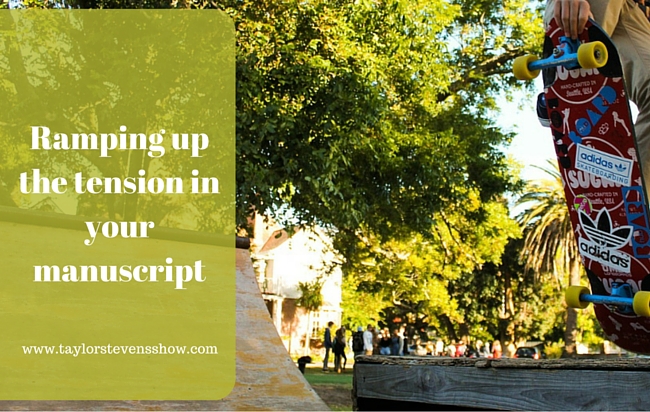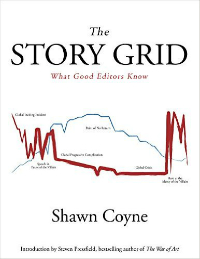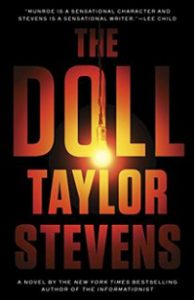
Podcast: Play in new window | Download
Subscribe: RSS
Today’s episode is all about tension, specifically, ways to ramp up the tension in your writing.
 But before we get to the show notes for today’s episode, we’d like to welcome you to the new home of The Taylor Stevens show. We’re exciting to have more room for show notes and to be able to share links to the books we mention during each show.
But before we get to the show notes for today’s episode, we’d like to welcome you to the new home of The Taylor Stevens show. We’re exciting to have more room for show notes and to be able to share links to the books we mention during each show.
Today’s show begins with a quick wrap up of Taylor’s early July trip to Thrillerfest in New York, which she describes as both tiring and fun. She participated in a panel discussion called: PLOTTER, PANSTER or HYBRID, The pros and cons of Outlining and shares some thoughts on the topic. We close the intro with Taylor’s surprising favorite New York City meal for this trip.
Then we get into the topic of raising the tension in your writing. Taylor offers several specific suggestions, including methods of raising the stakes by putting your character into either physical or emotional jeopardy.
 Taylor mentions THE STORY GRID, What Good Editors Know, by author and editor Shawn Coyne. It’s an excellent tool for writers and is something we’ve referenced multiple times on the show.
Taylor mentions THE STORY GRID, What Good Editors Know, by author and editor Shawn Coyne. It’s an excellent tool for writers and is something we’ve referenced multiple times on the show.
We specifically mention two of Tayor’s books as examples of putting characters into Jeopardy during the episode, and those were THE DOLL and THE INNOCENT.  In both novels, Munroe was rarely in physical danger, so Taylor used emotional risk as a way of ramping up the tension.
In both novels, Munroe was rarely in physical danger, so Taylor used emotional risk as a way of ramping up the tension.
Since this is our first show on the new show page, we’d love it if you would share the show on your social media platforms to help us grow the audience.
Thanks for Listening!
Thanks so much for joining us again this week.
If you enjoyed this episode, please share it using the social media buttons you see on the left of the post.
Also, please leave an honest review for THE TAYLOR STEVENS SHOW Podcast on iTunes!
Ratings and reviews are extremely helpful and mean a great deal to us. They matter in the rankings of the show, and we read every one of them.
And finally, don’t forget to subscribe to the show on iTunes or Stitcher to get automatic updates.
Creative Commons image by jamesvaughan
Quick note on this post: This is our first time using the new podcast feed which may present a problem for some listeners who have subscribed via WordPress, iTunes or some other methods. If you DID NOT receive this episode the way you normally receive the show please let me know in the comments.
Hi Taylor and Steve: As I mentioned on Facebook, where you are likely to get more comments, you raised the tension for me by reposting the previous episode. I missed you guys after two weeks.
I wanted to share something about tension that I learned from Brian De Palma on the movie Blow-Out. He starts with a scene that completely throws the audience off guard. The scene looks like it’s from a slasher movie instead of what the audience has paid to see. The slasher pulls back a curtain, a naked woman screams, the director in the mixing room yells cut, and we learn that the story is about the sound editor who has to go and find a better scream. Immediate ramping up of tension, a laugh, and we’re off to the races.
He said something like, you can take the audience anywhere in the first few minutes. Don’t waste the opportunity.
What a great opening. I can totally see how that Brian De Palma scenario would be brilliant on screen. In story-telling, “reversal” (where the viewer/reader believes s/he’s experiencing one thing only to discover it’s something else) is a really powerful tool.
As I sit here, I’m playing out the above scenario in my head trying to see how such a dramatic twist could be applied to the page vs the screen.
It can absolutely be done, but it can be really difficult to pull off–especially so for a beginning writer. The reason being that when words are used as the story medium, they have to be ordered in such a way that the reader is able to create a seamless movie in her own head.
That’s what makes writing a craft: structuring the flow of words in such a way that the mental movies evolve the way they are intended. Throw in the complication of a reversal or something similar to the slasher-not-slasher scene you mention above, and that challenge, like learning to drive on a stick shift vs. learning to drive on an automatic, gets multiplied many times over.
I one-hundred-percent agree with not wasting those first few minutes–or for writers, the opening pages.
Hitchcock used to say that you could ratchet up the tension on any boring dinner conversation. All you had to do was show a ticking time bomb under the table.
That was a memorable scene opening scene in Blow-Out, Bruce. I saw the movie when it came to the big screen in 1981 and haven’t seen it since. (Yes, I had to look the date up 😉 )